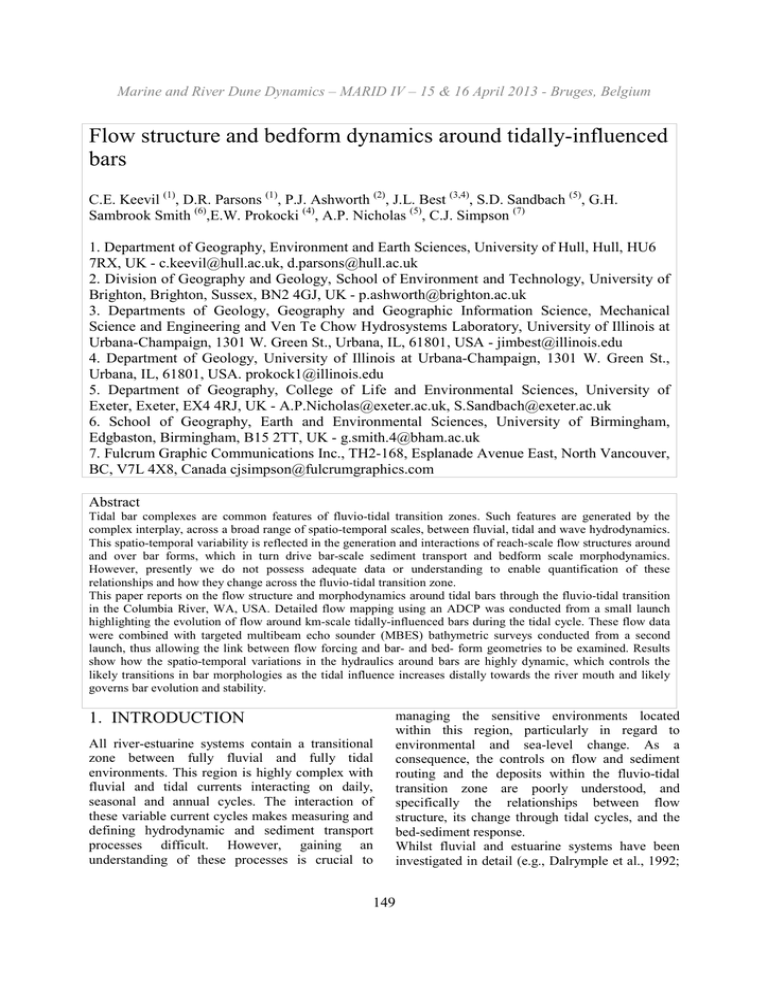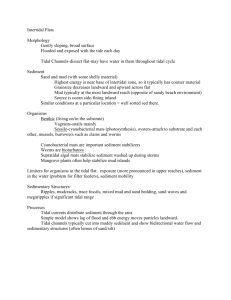Flow structure and bedform dynamics around tidally-influenced
advertisement

Marine and River Dune Dynamics – MARID IV – 15 & 16 April 2013 - Bruges, Belgium Flow structure and bedform dynamics around tidally-influenced bars C.E. Keevil (1), D.R. Parsons (1), P.J. Ashworth (2), J.L. Best (3,4), S.D. Sandbach (5), G.H. Sambrook Smith (6),E.W. Prokocki (4), A.P. Nicholas (5), C.J. Simpson (7) 1. Department of Geography, Environment and Earth Sciences, University of Hull, Hull, HU6 7RX, UK - c.keevil@hull.ac.uk, d.parsons@hull.ac.uk 2. Division of Geography and Geology, School of Environment and Technology, University of Brighton, Brighton, Sussex, BN2 4GJ, UK - p.ashworth@brighton.ac.uk 3. Departments of Geology, Geography and Geographic Information Science, Mechanical Science and Engineering and Ven Te Chow Hydrosystems Laboratory, University of Illinois at Urbana-Champaign, 1301 W. Green St., Urbana, IL, 61801, USA - jimbest@illinois.edu 4. Department of Geology, University of Illinois at Urbana-Champaign, 1301 W. Green St., Urbana, IL, 61801, USA. prokock1@illinois.edu 5. Department of Geography, College of Life and Environmental Sciences, University of Exeter, Exeter, EX4 4RJ, UK - A.P.Nicholas@exeter.ac.uk, S.Sandbach@exeter.ac.uk 6. School of Geography, Earth and Environmental Sciences, University of Birmingham, Edgbaston, Birmingham, B15 2TT, UK - g.smith.4@bham.ac.uk 7. Fulcrum Graphic Communications Inc., TH2-168, Esplanade Avenue East, North Vancouver, BC, V7L 4X8, Canada cjsimpson@fulcrumgraphics.com Abstract Tidal bar complexes are common features of fluvio-tidal transition zones. Such features are generated by the complex interplay, across a broad range of spatio-temporal scales, between fluvial, tidal and wave hydrodynamics. This spatio-temporal variability is reflected in the generation and interactions of reach-scale flow structures around and over bar forms, which in turn drive bar-scale sediment transport and bedform scale morphodynamics. However, presently we do not possess adequate data or understanding to enable quantification of these relationships and how they change across the fluvio-tidal transition zone. This paper reports on the flow structure and morphodynamics around tidal bars through the fluvio-tidal transition in the Columbia River, WA, USA. Detailed flow mapping using an ADCP was conducted from a small launch highlighting the evolution of flow around km-scale tidally-influenced bars during the tidal cycle. These flow data were combined with targeted multibeam echo sounder (MBES) bathymetric surveys conducted from a second launch, thus allowing the link between flow forcing and bar- and bed- form geometries to be examined. Results show how the spatio-temporal variations in the hydraulics around bars are highly dynamic, which controls the likely transitions in bar morphologies as the tidal influence increases distally towards the river mouth and likely governs bar evolution and stability. 1. INTRODUCTION All river-estuarine systems contain a transitional zone between fully fluvial and fully tidal environments. This region is highly complex with fluvial and tidal currents interacting on daily, seasonal and annual cycles. The interaction of these variable current cycles makes measuring and defining hydrodynamic and sediment transport processes difficult. However, gaining an understanding of these processes is crucial to 149 managing the sensitive environments located within this region, particularly in regard to environmental and sea-level change. As a consequence, the controls on flow and sediment routing and the deposits within the fluvio-tidal transition zone are poorly understood, and specifically the relationships between flow structure, its change through tidal cycles, and the bed-sediment response. Whilst fluvial and estuarine systems have been investigated in detail (e.g., Dalrymple et al., 1992; Marine and River Dune Dynamics – MARID IV – 15 & 16 April 2013 - Bruges, Belgium Dalrymple and Choi, 2007; Uncles, 2010; van den Berg et al., 2007), the transition zone has often been largely neglected. To understand the morphodynamic and sedimentary processes occurring within this region, from tidally dominated zones through to tidally-influenced river systems, the flow and the fluid forcing mechanisms must be considered in detail. 2. FIELDSITE The Columbia River Estuary (WA, USA) has a total drainage area of 660,480 km2, before entering the Pacific near Astoria, Oregon, USA (Simenstad et al., 2011). The river has an average discharge of 6,700 – 7,300 m3s-1 and a maximum tidal range of 3.6 m (Sherwood and Creager, 1990; Fain et al., 2001). It is a large estuarine system with contemporary and historic tidally-influenced bar construction (Figure 1). velocity and suspended sediment concentration along a set of pre-determined cross-sections around individual bar complexes, to investigate flow forcing and flow structure generated as fluvial-tidal interactions varied during the survey periods. MBES surveys were performed with a RESON SeaBat 7125 and POS-MV system. These surveys were carried out in June 2012 and measured channel bathymetry around the tidal bars. The morphologies obtained have permitted investigation of bedform interactions and bedform steering by tidal bar morphologies. 4. FLUID FLOW Flow was measured at both high and low tides around a bar head at several cross-sections (Figure 2). Two of these cross-sections lay upstream of the bar head, within a major anabranch of the river, whilst the other two were positioned either side of the bar head itself. The flows measured are shown in Figure 3. At low tide, flow in all parts of the channel flow field is in a downstream (ebb) direction, with lower velocities seen across topographic highs at the channel and bar edges. Maximum flow velocities in the sections reached over 1 ms-1, concentrated within the deepest parts of the channel. Flow in the shallower channel to the north of the bar head (cross-section D) was considerably lower, with maximum velocities of ~0.3 ms-1. Figure 1. The Columbia River Estuary, WA, USA. Well -developed bar complexes can be seen throughout the channel, some of which are vegetated. Data on two bars are presented herein: i. Sandee Bar, where ADCP measurements were carried out (Figs 2 and 3); and ii. Wills Bar where the MBES survey shown in Figure 4 was conducted. 3. METHODOLOGY The fluid flow, sediment transport and morphodynamics of a 40 km-reach of the river have been studied using acoustic Doppler current profiling (ADCP) and Multibeam Echosounding (MBES). Several bars within the reach were chosen for careful investigation. Herein we present results from two of the bars investigated. At each site, a 1200 kHz RDInstruments ADCP was deployed from a small launch during both 2011 and 2012, covering a number of tidal cycles. This provided measurements of three-dimensional flow 150 Figure 2. Position of ADCP lines around the bar head at Sandee Bar. Flows at high (flood) tide had much lower overall velocities, up to a maximum of ~0.4 ms-1, along with a distinct zone of flow reversal seen in two of the sections. Interestingly, flow at cross-section A shows a weak upstream flow in the deepest parts of the main channel, with slightly stronger Marine and River Dune Dynamics – MARID IV – 15 & 16 April 2013 - Bruges, Belgium downstream flow in the shallower areas of the cross-section to the north. Cross-section D shows velocity in shown in cms-1. Note scales vary between sub-panels an increase in ebb-directed flow during the flood, indicating a significant influence of tidal bar topography in steering the flow driving the incoming flood into the topographic lows, with much higher variability in flow direction across topographic highs in response. 5. BEDFORMS Although the region studied shows bi-directional flow through the tidal cycle, the bedforms identified across the bar head at Wills Bar (Figures 1, 4) have dominantly unidirectional, asymmetric, ebb-directed geometries, with long stoss sides with sharp crests. Large dunes are found throughout the estuary system, commonly with flattened crests. Figure 4 shows that dunes upstream of the bar head have crests orientated in a NE-SW direction (normal to the bar head apex). As the channel bifurcates, the orientation of the dunes changes as they are steered around the bar head. In the larger southern channel, flow is deeper and the dunes become longer in wavelength and straighter crested. Here, the dunes crests are N-S in orientation. In the smaller northern channel, the flow is shallower and dune amplitude declines significantly. Figure 3. Streamwise flow around a bar head measured at four positions on 1) the outgoing (low/ebb) and, 2) incoming (high/flood) tides. Section positions are shown on Figure 2. All images show flow facing in a downstream direction. Water depth and distance from left bank are shown in metres, while streamwise flow 151 Figure 4. Large dunes showing some steering and pronounced decay around a bar head at Wills Bar (location shown in Figure 1). Flow is diverted from the main river channel at the bottom right of the image and separates around a large bar. Marine and River Dune Dynamics – MARID IV – 15 & 16 April 2013 - Bruges, Belgium 6. CONCLUSIONS Flow fields around tidal bars have significant variability that is driven by the response and interactions of the tidal flow and topographic forcing. This can result in appreciable steering of flow at tidal bar heads, with notable implications for bar morphodynamics of and their sedimentology. For example, there is little evidence for variation in bedform asymmetry through the reaches examined herein. However, the multibeam surveys presented herein have allowed a first view of this flow steering effect and future repeat surveys will be carried out across a complete tidal cycle to determine sediment transport rates and directions. Full threedimensional flow data will be examined in the near future to elucidate the secondary flow components and evolution of channel scale helicity and the role it plays in sediment routing round these key features of the fluvial-tidal transition zone. 7. ACKNOWLEDGMENTS The work in this project was carried out as part of NERC grant NE/H007954/1. Thanks CMOP (Portland), Clatsop College and MERTS in Astoria, OR (Michael Wilkin in particular), Pat and Sandee Killion, and Mike Stecher. 8. REFERENCES Dalrymple, R.W. & Choi, K. 2007. Morphologic and facies trends through the fluvial-marine transition in 152 tide-dominated depositional systems: A schematic framework for environmental and sequencestratigraphic interpretation. Earth-Science Reviews 81: 135-174. Dalrymple, R.W., Zaitlin, B.A. & Boyd, R. 1992. Estuarine facies models: Conceptual basis and stratigraphic implications. Journal of Sedimentary Petrology 62: 1130-1146. Fain, A.M.V., Jay, D.A., Wilson, D.J., Orton, P.M. & Baptista, A.M. 2001. Seasonal and tidal monthly patterns of particulate matter dynamics in the Columbia River Estuary. Estuaries 24: 770-786. Sherwood, C.P. & Creager, J.S. 1990. Sedimentary geology of the Columbia River Estuary. Progress in Oceanography 25: 15-79. Simenstad, C.A., Burke, J.L., O’Connor, J.E., Cannon, C., Heatwole, D.W., Ramirez, M.F., Waite, I.R., Counihan, T.D. & Jones, K.L. 2011. Columbia River Estuary Ecosystem Classification—Concept and Application: U.S. Geological Survey Open-File Report 2011-1228, 54 pp. Uncles, R.J. 2010. Physical properties and processes in the Bristol Channel and Severn Estuary. Marine Pollution Bulletin 61: 5-20. van den Berg, J.H., Boersma, J.R. & van Gelder, A. 2007. Diagnostic sedimentary structures of the fluvial-tidal transition zone – Evidence from deposits of the Rhine and Meuse. Geologie en Mijnbouw (Netherlands Journal of Geosciences) 86: 287-306.






